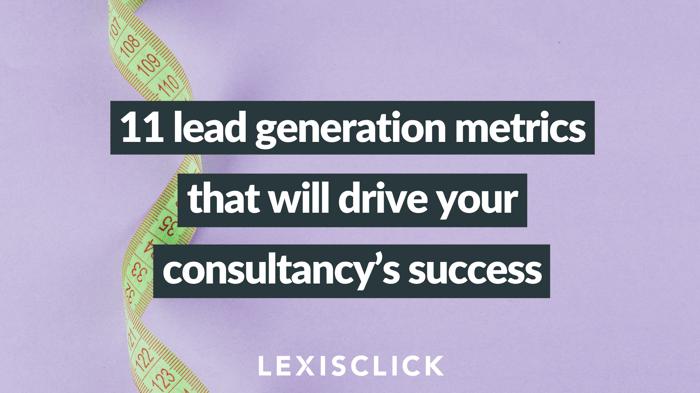
Are you struggling to hit your growth targets consistently? Are you not generating the quality sales-ready leads that would mean you’d hit those targets? Are you seeing little return on your marketing investments? Solving these issues can start by tracking the right metrics.
There’s a well known saying - “What gets measured gets managed.” However, to get the results you want, you have to measure and manage the right things. What better place to learn than from the most successful consultancies.
- The wrong metrics will send you on a wild goose chase
- Your lead generation is a system with inputs and outputs
- The 11 lead generation metrics that all successful consultancies use
- 1) Landing page visits
- 2) Qualified leads generated
- 3) Landing page conversion rate
- 4) Marketing qualified leads generated (MQLs)
- 5) Qualified lead to MQL conversion rate
- 6) Cost per MQL
- 7) Sales qualified leads generated (SQLs)
- 8) MQL to SQL conversion rate
- 9) Deals created
- 10) Average deal value
- 11) Return on marketing investment
- Avoiding data overload
- Assess your lead generation
- Drive your impact
The wrong metrics will send you on a wild goose chase
It’s all too easy to measure the wrong things. Things like:
-
Website visitors
-
Social media followers
-
Social media likes
-
Video views
-
Leads generated
Are you measuring any of these metrics? It’s not that they don’t have a place and value when used in the proper context. However, they’re unlikely to directly help you generate the leads you need to achieve your growth targets.
Do you truly understand the metrics you are reporting on? If you don’t, you’ll struggle to take advantage of Pearson’s Law:
“When performance is measured, performance improves. When performance is measured and reported back, the rate of improvement accelerates.”
This law means that if you focus on reporting and managing the wrong metric, like website visitors, you will improve it. However, if your website visitors aren’t the right fit or you don’t have the right message on your website, you won’t get the outcome you want, which is more quality leads that convert to high-value customers.

Your lead generation is a system with inputs and outputs
If you aren’t generating the leads you need, the metrics I share below will help you get things on the right track. However, before you get too caught up in the metrics, make sure you have the crucial steps of defining your ideal customer, crafting a compelling message that attracts them and creating an irresistible offer to deliver the outcome you promise.
If you want the "how-to" on defining those steps, check out our Lead Generation Planning Pack for Consultants.
Without those in place, you’ll lack the clarity to attract them and identify improvements from the metrics you’ll put in place. Whereas having the metrics I share below will massively accelerate your progress.
Lead generation is a system that comprises various components. You’ll have channels that you use, processes and various systems like your website content management system and your CRM.
Like any system, it’ll have inputs and outputs. As it’s a relatively complex system made up of various components and subsystems, each of these will also have its own input and output metrics to consider.
Before long, you can drown in metrics. To get the results and outcome that you want, you must focus on the right metrics.
When you’re tracking anything, you’ll have three types of metrics to consider:
- Input metrics or leading indicators
- Output metrics or lagging indicators
- System performance metrics, e.g. conversion rate.
Input metrics are the metrics that you have direct control over. That’s why you want to understand their relationship with the output metrics that you’re targeting.
An example could be sales conversations held and sales made. You might know that your sales conversations convert at a rate of 10% to sales made on average. This conversion rate means that to make 10 sales, your sales team would have to have 100 sales conversations on average.
In this example, sales conversations are your input metric, a leading indicator, and sales made is your output metric or lagging indicator.
You would quickly see that if your sales team only had 10 sales conversations in a week, they are well behind their target of the 25 sales conversations they need to achieve your monthly sales target.
Reporting this back to them, you could increase their target to 30 sales conversations a week for the remaining three weeks of the month to get them back on track to achieving the input metric.
Without this leading indicator, you’d only know they hadn’t performed when you made fewer sales at the end of the month.
You could also keep tabs on whether the input is converting to output at the correct rate using your sales conversion rate metric.
If the target conversion rate isn’t achieved, you can dig deeper into the system to understand why it wasn’t performing at the expected rate, which will increase your chances of getting it fixed and achieving your targets.
The output metrics of one system may also be the input metric for another system. The types I have listed below are the most typical type that the metric falls under when used in a lead generation system.
The list of the 12 most important metrics doesn’t cover every system you’ll have running; however, it is a list of the critical metrics you want to measure in your consultancy lead generation.
The 11 lead generation metrics that all successful consultancies use

1) Landing page visits
Metric Type: Input Metric
Explanation:
Not all website visits are created equal. You’ll have a variety of pages on your website, all doing different jobs. Your landing pages are the pages that have the sole purpose of generating leads. So these are the visits you want to measure. When you have some qualification criteria built into these landing pages, it’ll lead naturally into the next metric you want to measure - qualified leads generated.
2) Qualified leads generated
Metric Type: Output Metric
Explanation:
Qualified leads are typically the right person at the right company with the right problem. They may imply their problem by downloading a particular resource or using a tool aligned with the problem. Or it may be declared by the lead telling you in a form submission that they have the problem.
Successful consultancies understand that a new contact is of minimal value until qualified against the correct criteria.
3) Landing page conversion rate
Metric Type: System Metric
Explanation:
This is the metric you can use to understand how well your landing pages are performing. You’ll typically be aiming for a conversion rate of at least ten percent on your landing pages. If it is any lower, it is a sure sign that either the landing page isn’t compelling enough, or you have the wrong people visiting it. Either way, your conversion rate is an immediate indicator of the performance of your landing pages.
4) Marketing qualified leads generated (MQLs)
Metric Type: Output Metric for lead generation, Input metric for SDR process.
Explanation:
MQLs generated is probably the most significant of your lead generation metrics. The consultancies that we work with define MQLs as qualified leads that have indicated they want to have a conversation with you.
When your marketing system is performing well, your sales team should have all the leads they need from people who want to speak with you. Naturally, some people will get stuck in the system, and this is where your sales development reps can come in handy to help everyone move along your system fluidly.
5) Qualified lead to MQL conversion rate
Metric Type: System Metric
Explanation:
This is the system metric to understand how well your marketing and lead nurture systems perform. Their job is to convert the qualified leads you are generating to marketing qualified leads who want a conversation with you. This conversion rate gives you an immediate indicator of how this part of your process is performing.
6) Cost per MQL
Metric Type: System Metric
Explanation:
Cost per MQL is a system metric you can use to understand what it costs you to generate your MQLs. You’ll need to know your total marketing costs and the number of MQLs generated to calculate the number. However, your cost per MQL is the most important number as this gives you an understanding of performance. It also allows you to accurately compare periods even when the metrics used to calculate it may vary from month to month with seasonality, tactical or budget changes.
7) Sales qualified leads generated (SQLs)
Metric Type: Output Metric
Explanation:
SQLs indicate whether leads are considered qualified by your sales team. It is really a sales metric; however, as the contact's status is still a lead, it is also a lead generation metric. You may well have sales-led lead generation activities taking place as well as marketing-led activities. If you do have both, SQLs are an essential metric that will provide a view of how all of your lead generation activities are performing.
It also forms an essential part of understanding whether your lead generation is providing the right leads. If your MQLs aren’t converting to SQLs, you have a problem, which is where the next metric comes into play.
8) MQL to SQL conversion rate
Metric Type: System Metric
Explanation:
Like the other system metrics measuring conversion rate, measuring your MQL to SQL conversion rates provides you with an immediate understanding of how this crucial part of your lead generation system is performing. If the conversion rate is low, either the MQLs you’re generating aren’t the right quality, or your sales qualification process is at fault. Either way, this metric will help you measure and manage the handover from marketing to sales.
9) Deals created
Metric Type: Output Metric (for lead generation process)
Explanation:
If you have one or more people in your sales team, you must have a deal on the table to make a sale. Deals are how you can measure that your lead generation is converting to sales opportunities. Revenue is subject to sales cycles, often delaying it as a metric suitable for frequent management reviews. Deals created is a near term metric that is more suitable for the job.
10) Average deal value
Metric Type: Output Metric
Explanation:
The most successful consultancies don’t want any customers; they want ideal customers. Their ideal customers will have many attributes; however, their value is a standard metric. Reporting on your average deal value will give you a good sense of whether you’re attracting the right leads or not.
11) Return on marketing investment
Metric Type: Output Metric
Explanation:
Ideally, you’ll report on your return on marketing investment using actual revenue generated. However, depending on your sales cycle, the delay may be too considerable for meaningful management. If you have a sales cycle longer than four weeks, use the total deal value created instead. This metric will give you a good sense of your marketing return on investment in the near term that you can expand on at quarterly or annual intervals with actual revenue to increase accuracy.
Avoiding data overload
This may sound like a lot to take on board. Many consultancies measure very little when it comes to their lead generation. However, the most successful consultancies take these metrics very seriously.
If you’re starting from measuring little - start small. Choose three or four most valuable metrics, measure them, and report on them at least monthly and ideally weekly.
If you’re already measuring many of these, but you’re not making the improvements you want, are you identifying the issues and taking action?
Metrics have no value if you’re not taking action on them. Decide who in your team is responsible for which metrics and have a regular review meeting. Use the review meeting to identify improvements and agree on actions. Remember to set SMART goals, assign responsibility and manage their delivery. Review your agreed actions early on in each meeting and hold the people responsible for delivering them.
Assess your lead generation
If your lead generation isn’t performing, the chances are that it’s more than just your metrics that needs some work. We’ve created a Lead Gen Scorecard to help you identify the issues and learn what you can do to fix them.
Drive your impact
As a consultancy, you are excellent at solving problems for your ideal customers. However, getting in front of them and generating the leads is probably holding you back from solving those problems at scale and having an even more significant impact in the world.
Just imagine the impact you can make when solving those problems at a much larger scale than you are today. It all starts by generating the right leads at the right level. Apply Pearson’s Law to your consultancy and get the critical metrics in place.


